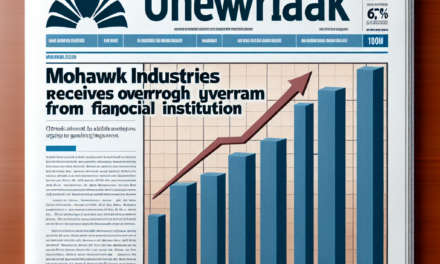“Thyssenkrupp: Navigating Challenges, Reducing Losses, Building a Resilient Future.”
Introduction
Thyssenkrupp, the German multinational conglomerate, has reported a significant reduction in its net loss, marking a pivotal moment in its financial recovery efforts. This improvement comes in the wake of substantial impairments that had previously weighed heavily on the company’s financial performance. The latest financial results reflect Thyssenkrupp’s strategic initiatives aimed at streamlining operations, enhancing efficiency, and focusing on core business areas. As the company navigates through challenging market conditions, the reduced net loss underscores its commitment to financial stability and long-term growth.
Analysis Of Thyssenkrupp’s Financial Recovery Strategies
Thyssenkrupp, a prominent player in the global industrial sector, has recently reported a reduced net loss, marking a significant milestone in its ongoing financial recovery efforts. This development comes in the wake of strategic impairments and a series of calculated measures aimed at stabilizing the company’s financial health. As the company navigates through a challenging economic landscape, understanding the intricacies of its recovery strategies provides valuable insights into its future trajectory.
To begin with, Thyssenkrupp’s decision to implement impairments was a pivotal move in addressing its financial challenges. By recognizing and writing down the value of underperforming assets, the company has taken a proactive approach to align its balance sheet with current market realities. This not only reflects a commitment to transparency but also positions the company to make more informed strategic decisions moving forward. The impairments, while initially contributing to the net loss, have ultimately paved the way for a more accurate representation of the company’s financial standing.
In addition to impairments, Thyssenkrupp has embarked on a comprehensive restructuring plan aimed at streamlining operations and enhancing efficiency. This plan involves divesting non-core assets, which allows the company to focus on its core competencies and invest in areas with higher growth potential. By shedding businesses that do not align with its long-term strategic goals, Thyssenkrupp is better positioned to allocate resources effectively and drive sustainable growth. This strategic realignment is crucial in a competitive market where agility and focus are key determinants of success.
Moreover, Thyssenkrupp’s emphasis on innovation and technological advancement plays a central role in its recovery strategy. The company has been investing in research and development to foster innovation across its various business segments. By leveraging cutting-edge technologies, Thyssenkrupp aims to enhance its product offerings and improve operational efficiencies. This focus on innovation not only strengthens its competitive edge but also opens up new revenue streams, thereby contributing to its financial recovery.
Furthermore, Thyssenkrupp’s commitment to sustainability is an integral component of its recovery strategy. The company recognizes the growing importance of environmental, social, and governance (ESG) factors in shaping business success. By integrating sustainable practices into its operations, Thyssenkrupp is not only meeting regulatory requirements but also aligning with the evolving expectations of stakeholders. This commitment to sustainability enhances the company’s reputation and positions it as a responsible corporate citizen, which can translate into long-term financial benefits.
In parallel, Thyssenkrupp has been actively managing its debt profile to improve financial stability. By refinancing existing debt and optimizing its capital structure, the company aims to reduce interest expenses and enhance liquidity. This prudent financial management is essential in ensuring that Thyssenkrupp has the flexibility to navigate economic uncertainties and seize growth opportunities as they arise.
In conclusion, Thyssenkrupp’s reduced net loss is a testament to the effectiveness of its financial recovery strategies. Through strategic impairments, restructuring efforts, a focus on innovation, a commitment to sustainability, and prudent financial management, the company is laying a solid foundation for future growth. While challenges remain, Thyssenkrupp’s proactive approach and strategic initiatives position it well to overcome obstacles and achieve long-term financial stability. As the company continues to execute its recovery plan, stakeholders will be keenly observing its progress and the impact of these strategies on its overall performance.
Impact Of Impairments On Thyssenkrupp’s Financial Health
Thyssenkrupp, a prominent player in the global industrial sector, recently reported a reduced net loss, a development that has drawn considerable attention from investors and analysts alike. This improvement in financial performance comes in the wake of significant impairments, which have played a crucial role in reshaping the company’s financial health. To understand the impact of these impairments, it is essential to delve into the underlying factors that have influenced Thyssenkrupp’s recent financial outcomes.
Impairments, in the context of financial reporting, refer to the reduction in the recoverable value of an asset below its carrying amount on the balance sheet. For Thyssenkrupp, these impairments have been primarily associated with its steel division, which has faced numerous challenges over the past few years. The global steel industry has been grappling with overcapacity, fluctuating demand, and volatile raw material prices, all of which have exerted pressure on profit margins. Consequently, Thyssenkrupp has had to reassess the value of its steel assets, leading to substantial write-downs.
Despite the negative connotations typically associated with impairments, Thyssenkrupp’s decision to recognize these losses has had a paradoxically positive effect on its financial health. By acknowledging the diminished value of its assets, the company has been able to present a more accurate and transparent financial picture. This transparency is crucial for maintaining investor confidence, as it demonstrates Thyssenkrupp’s commitment to addressing its challenges head-on and taking the necessary steps to realign its business strategy.
Moreover, the impairments have prompted Thyssenkrupp to undertake a comprehensive restructuring of its operations. This restructuring has involved divesting non-core assets, streamlining processes, and focusing on more profitable segments of the business. As a result, the company has been able to reduce its operational costs and improve its overall efficiency. These strategic moves have not only contributed to the reduction in net loss but have also positioned Thyssenkrupp for future growth and profitability.
In addition to operational improvements, the impairments have also influenced Thyssenkrupp’s approach to capital allocation. With a clearer understanding of the value of its assets, the company has been able to make more informed decisions regarding investments and resource allocation. This has enabled Thyssenkrupp to prioritize projects with higher potential returns, thereby enhancing its long-term financial stability.
Furthermore, the reduced net loss reported by Thyssenkrupp can be seen as a reflection of the broader economic environment. As global markets continue to recover from the disruptions caused by the COVID-19 pandemic, demand for industrial products, including steel, has shown signs of improvement. This recovery has provided a tailwind for Thyssenkrupp, allowing it to capitalize on emerging opportunities and further strengthen its financial position.
In conclusion, while impairments are often viewed as a negative indicator of a company’s financial health, Thyssenkrupp’s recent experience demonstrates that they can also serve as a catalyst for positive change. By confronting the challenges facing its steel division and implementing strategic restructuring measures, Thyssenkrupp has been able to reduce its net loss and lay the groundwork for a more sustainable future. As the company continues to navigate the complexities of the global industrial landscape, its proactive approach to managing impairments will likely play a pivotal role in shaping its financial trajectory.
Thyssenkrupp’s Path To Reduced Net Loss: Key Factors
Thyssenkrupp, a prominent player in the global industrial sector, has recently reported a reduced net loss, marking a significant development in its financial trajectory. This improvement comes in the wake of strategic decisions and operational adjustments that have been pivotal in reshaping the company’s financial landscape. The reduction in net loss is primarily attributed to a series of impairments that Thyssenkrupp has undertaken, which have played a crucial role in streamlining its operations and enhancing its financial health.
To understand the factors contributing to this reduced net loss, it is essential to examine the strategic measures implemented by Thyssenkrupp. The company has been actively engaged in restructuring efforts aimed at optimizing its portfolio and focusing on core areas of strength. This strategic realignment has involved divesting non-core assets, thereby allowing Thyssenkrupp to concentrate resources on more profitable and sustainable business segments. By shedding underperforming units, the company has not only improved its operational efficiency but also bolstered its financial position.
Moreover, Thyssenkrupp’s commitment to innovation and technological advancement has been instrumental in driving its recovery. The company has invested significantly in research and development, seeking to enhance its product offerings and maintain a competitive edge in the market. This focus on innovation has enabled Thyssenkrupp to tap into new growth opportunities, particularly in sectors such as renewable energy and sustainable infrastructure, which are gaining increasing importance in the global economy. By aligning its business strategy with emerging market trends, Thyssenkrupp has positioned itself to capitalize on future growth prospects.
In addition to these strategic initiatives, Thyssenkrupp has also benefited from favorable market conditions that have supported its financial recovery. The global economic environment has shown signs of improvement, with increased demand for industrial products and services. This uptick in demand has provided a much-needed boost to Thyssenkrupp’s revenue streams, helping to offset some of the financial challenges it has faced in recent years. Furthermore, the company’s efforts to enhance operational efficiency have resulted in cost savings, contributing to the overall reduction in net loss.
It is also worth noting that Thyssenkrupp’s management has played a pivotal role in steering the company towards financial stability. The leadership team has demonstrated a clear vision and commitment to executing the company’s strategic plan, ensuring that all efforts are aligned with the overarching goal of achieving sustainable profitability. This strong leadership has been crucial in navigating the complexities of the industrial sector and addressing the challenges posed by a rapidly changing business environment.
In conclusion, Thyssenkrupp’s reduced net loss is the result of a multifaceted approach that combines strategic realignment, innovation, market responsiveness, and effective leadership. By focusing on core strengths, investing in future growth areas, and optimizing operational efficiency, the company has made significant strides in improving its financial performance. As Thyssenkrupp continues on this path, it remains well-positioned to build on its recent successes and achieve long-term financial stability. The journey towards reduced net loss underscores the importance of adaptability and strategic foresight in navigating the complexities of the modern industrial landscape.
Understanding Thyssenkrupp’s Recent Financial Performance

Thyssenkrupp, a prominent player in the global industrial sector, has recently reported a reduced net loss, marking a significant development in its financial performance. This improvement comes in the wake of substantial impairments that the company has had to navigate. To understand the nuances of this financial outcome, it is essential to delve into the factors that have influenced Thyssenkrupp’s recent performance and the strategic decisions that have been pivotal in shaping its current financial landscape.
The company’s financial results have been closely watched by industry analysts and investors alike, given its historical significance and the challenges it has faced in recent years. Thyssenkrupp’s journey has been marked by a series of strategic shifts, including divestitures and restructuring efforts, aimed at streamlining operations and focusing on core business areas. These efforts have been instrumental in mitigating the impact of impairments, which have been a significant factor in the company’s financial narrative.
Impairments, in the context of Thyssenkrupp, refer to the write-downs of asset values that have been necessitated by changing market conditions and strategic realignments. These write-downs, while impacting short-term financial results, are often seen as a necessary step in aligning the company’s asset base with its long-term strategic objectives. By addressing these impairments head-on, Thyssenkrupp has demonstrated a commitment to transparency and financial prudence, which are crucial for maintaining investor confidence.
Moreover, the reduced net loss reported by Thyssenkrupp can be attributed to several key factors. Firstly, the company’s focus on operational efficiency has yielded tangible results, as evidenced by cost-saving measures and process optimizations across various business units. These initiatives have not only helped in offsetting the impact of impairments but have also laid the groundwork for sustainable financial performance in the future.
In addition to operational improvements, Thyssenkrupp’s strategic divestitures have played a crucial role in reshaping its financial profile. By divesting non-core assets, the company has been able to generate liquidity and reduce debt, thereby strengthening its balance sheet. This strategic focus on core competencies has allowed Thyssenkrupp to allocate resources more effectively and pursue growth opportunities in areas where it holds a competitive advantage.
Furthermore, the company’s commitment to innovation and technological advancement has been a driving force behind its recent financial performance. By investing in research and development, Thyssenkrupp has been able to enhance its product offerings and cater to evolving market demands. This focus on innovation not only supports revenue growth but also positions the company as a leader in key industrial sectors.
As Thyssenkrupp continues to navigate the complexities of the global market, its recent financial performance serves as a testament to the effectiveness of its strategic initiatives. While challenges remain, particularly in the form of market volatility and geopolitical uncertainties, the company’s proactive approach to addressing impairments and optimizing operations provides a solid foundation for future growth.
In conclusion, Thyssenkrupp’s reduced net loss following impairments underscores the importance of strategic realignment and operational efficiency in achieving financial stability. By focusing on core strengths, divesting non-essential assets, and investing in innovation, the company has positioned itself to capitalize on emerging opportunities and deliver value to its stakeholders. As the industrial landscape continues to evolve, Thyssenkrupp’s commitment to adaptability and resilience will be key to sustaining its financial momentum.
The Role Of Impairments In Thyssenkrupp’s Financial Turnaround
Thyssenkrupp, a prominent player in the global industrial sector, has recently reported a reduced net loss, marking a significant milestone in its ongoing financial turnaround. This improvement is largely attributed to strategic impairments, which have played a crucial role in reshaping the company’s financial landscape. Understanding the impact of these impairments provides valuable insight into how Thyssenkrupp is navigating its path to recovery.
Impairments, in the context of financial accounting, refer to the reduction in the recoverable value of an asset below its carrying amount. For Thyssenkrupp, these impairments have been instrumental in aligning the company’s asset values with current market realities. By recognizing impairments, the company has been able to address overvalued assets on its balance sheet, thereby providing a more accurate representation of its financial health. This strategic move not only enhances transparency but also builds investor confidence, which is essential for a company seeking to regain its footing in a competitive market.
The decision to implement impairments is often driven by a comprehensive assessment of market conditions and future cash flow projections. In Thyssenkrupp’s case, the impairments were primarily focused on underperforming business units and assets that no longer aligned with the company’s long-term strategic goals. By divesting or restructuring these assets, Thyssenkrupp has been able to streamline its operations and focus on core areas that promise sustainable growth. This strategic realignment is a testament to the company’s commitment to optimizing its portfolio and enhancing operational efficiency.
Moreover, the role of impairments in Thyssenkrupp’s financial turnaround extends beyond mere accounting adjustments. They have facilitated a broader transformation within the organization, prompting a reevaluation of business strategies and operational practices. This introspective approach has led to the identification of new growth opportunities and the implementation of innovative solutions aimed at driving profitability. As a result, Thyssenkrupp is better positioned to adapt to changing market dynamics and capitalize on emerging trends.
In addition to their immediate financial impact, impairments have also influenced Thyssenkrupp’s long-term strategic planning. By acknowledging the need for change and taking decisive action, the company has demonstrated a proactive approach to risk management. This forward-thinking mindset is crucial in an industry characterized by rapid technological advancements and evolving customer demands. By embracing change and leveraging impairments as a tool for transformation, Thyssenkrupp is laying the groundwork for a more resilient and agile organization.
Furthermore, the reduced net loss reported by Thyssenkrupp underscores the effectiveness of its impairment strategy. While the road to recovery is often fraught with challenges, the company’s ability to mitigate losses and stabilize its financial position is a positive indicator of progress. This achievement not only reflects the success of its current initiatives but also sets the stage for future growth and profitability.
In conclusion, the role of impairments in Thyssenkrupp’s financial turnaround cannot be overstated. By addressing overvalued assets and realigning its strategic focus, the company has made significant strides toward achieving financial stability. As Thyssenkrupp continues to navigate its recovery journey, the lessons learned from this experience will undoubtedly inform its future endeavors, ensuring that it remains a formidable force in the global industrial landscape. Through strategic impairments and a commitment to transformation, Thyssenkrupp is poised to emerge stronger and more competitive in the years to come.
Thyssenkrupp’s Strategic Adjustments For Financial Stability
Thyssenkrupp, a prominent player in the global industrial sector, has recently reported a reduced net loss, marking a significant development in its ongoing efforts to achieve financial stability. This improvement comes in the wake of strategic adjustments and a series of impairments that have been meticulously implemented to streamline operations and enhance the company’s financial health. As the company navigates the complexities of the modern industrial landscape, these measures underscore its commitment to long-term sustainability and resilience.
The reduction in net loss is a testament to Thyssenkrupp’s proactive approach in addressing the challenges that have beset the industry. By undertaking a comprehensive review of its asset portfolio, the company has identified and executed necessary impairments, thereby aligning its financial statements more closely with current market realities. This strategic move not only reflects a prudent assessment of asset values but also positions Thyssenkrupp to better capitalize on future opportunities. The impairments, while initially impacting the bottom line, are expected to yield long-term benefits by eliminating underperforming assets and refocusing resources on more promising ventures.
In addition to asset impairments, Thyssenkrupp has embarked on a series of strategic adjustments aimed at bolstering its financial stability. Central to these efforts is the company’s commitment to operational efficiency and cost optimization. By streamlining processes and implementing lean management practices, Thyssenkrupp has been able to reduce operational costs, thereby improving its overall financial performance. These measures are complemented by a renewed focus on core business areas, which allows the company to concentrate its efforts on sectors where it holds a competitive advantage.
Moreover, Thyssenkrupp’s strategic adjustments extend beyond internal restructuring to encompass a broader market-oriented approach. The company has been actively pursuing partnerships and collaborations that enhance its technological capabilities and expand its market reach. By leveraging synergies with other industry leaders, Thyssenkrupp is well-positioned to drive innovation and deliver value-added solutions to its customers. This collaborative approach not only strengthens the company’s market position but also fosters a culture of innovation that is essential for long-term growth.
Furthermore, Thyssenkrupp’s commitment to sustainability and environmental responsibility is an integral component of its strategic adjustments. Recognizing the growing importance of sustainable practices in the industrial sector, the company has made significant investments in green technologies and sustainable production methods. These initiatives not only align with global environmental standards but also enhance Thyssenkrupp’s reputation as a responsible corporate citizen. By integrating sustainability into its business model, the company is poised to meet the evolving demands of customers and stakeholders alike.
In conclusion, Thyssenkrupp’s reduced net loss following impairments is indicative of the company’s strategic adjustments aimed at achieving financial stability. Through a combination of asset impairments, operational efficiency, market-oriented strategies, and a commitment to sustainability, Thyssenkrupp is laying the groundwork for a more resilient and prosperous future. As the company continues to navigate the challenges of the industrial sector, these strategic measures will undoubtedly play a crucial role in shaping its trajectory and ensuring its long-term success.
Future Outlook For Thyssenkrupp Post-Reduced Net Loss
Thyssenkrupp, a prominent player in the global industrial sector, has recently reported a reduced net loss, marking a significant turning point for the company following a series of impairments. This development is pivotal as it not only reflects the company’s resilience but also sets the stage for its future trajectory. The reduction in net loss can be attributed to strategic decisions and operational adjustments that have been implemented over the past few quarters. These measures have been crucial in stabilizing the company’s financial health and positioning it for potential growth.
The impairments, which were a necessary step in recalibrating the company’s asset valuations, have had a profound impact on Thyssenkrupp’s financial statements. By addressing these impairments head-on, the company has been able to clear a path towards a more sustainable financial structure. This move, while challenging, underscores Thyssenkrupp’s commitment to transparency and long-term viability. As a result, stakeholders can now look forward to a more robust and strategically aligned organization.
In light of these developments, Thyssenkrupp’s management has expressed cautious optimism about the future. The company’s leadership is keenly aware of the challenges that lie ahead, particularly in an ever-evolving industrial landscape. However, they are equally confident in the strategies that have been put in place to navigate these challenges. One of the key areas of focus for Thyssenkrupp moving forward is innovation. By investing in research and development, the company aims to enhance its product offerings and maintain a competitive edge in the market. This commitment to innovation is expected to drive growth and open up new revenue streams.
Moreover, Thyssenkrupp is placing a strong emphasis on sustainability, recognizing its importance in today’s business environment. The company is actively working towards reducing its carbon footprint and implementing environmentally friendly practices across its operations. This focus on sustainability not only aligns with global trends but also resonates with stakeholders who are increasingly prioritizing environmental responsibility. By integrating sustainable practices into its core operations, Thyssenkrupp is positioning itself as a forward-thinking leader in the industry.
In addition to innovation and sustainability, Thyssenkrupp is also exploring strategic partnerships and collaborations. By leveraging synergies with other industry players, the company aims to enhance its capabilities and expand its market reach. These partnerships are expected to provide Thyssenkrupp with access to new technologies and markets, further strengthening its competitive position.
While the road ahead is not without its challenges, Thyssenkrupp’s recent financial performance provides a solid foundation for future growth. The company’s ability to adapt to changing market conditions and its proactive approach to addressing financial impairments are indicative of a resilient organization poised for success. As Thyssenkrupp continues to implement its strategic initiatives, stakeholders can remain hopeful about the company’s prospects.
In conclusion, Thyssenkrupp’s reduced net loss following impairments marks a significant milestone in its journey towards financial stability and growth. Through a focus on innovation, sustainability, and strategic partnerships, the company is well-positioned to navigate the complexities of the industrial sector. As it moves forward, Thyssenkrupp’s commitment to these core areas will be instrumental in shaping its future and ensuring long-term success.
Q&A
1. **What is the main focus of the Thyssenkrupp report?**
The report focuses on Thyssenkrupp’s financial performance, highlighting a reduced net loss following impairments.
2. **What financial metric showed improvement for Thyssenkrupp?**
Thyssenkrupp reported a reduced net loss, indicating an improvement in their financial performance.
3. **What caused the impairments mentioned in the report?**
The impairments were likely due to write-downs on assets or investments that had decreased in value.
4. **How did the impairments affect Thyssenkrupp’s financial results?**
The impairments initially increased the net loss, but subsequent measures or improvements led to a reduction in the overall net loss.
5. **What strategies might Thyssenkrupp have implemented to reduce the net loss?**
Possible strategies include cost-cutting measures, restructuring, divestments, or operational improvements.
6. **What is the significance of the reduced net loss for Thyssenkrupp?**
A reduced net loss signifies better financial health and could improve investor confidence and market perception.
7. **What future outlook or guidance did Thyssenkrupp provide in the report?**
The report might have included optimistic guidance or strategic plans to continue improving financial performance and addressing challenges.
Conclusion
Thyssenkrupp’s financial performance has shown improvement as the company reported a reduced net loss following significant impairments. This indicates that the strategic measures and restructuring efforts undertaken by the company are beginning to yield positive results. The reduction in net loss suggests enhanced operational efficiency and cost management, positioning Thyssenkrupp on a more stable financial footing. However, continued focus on addressing underlying challenges and capitalizing on growth opportunities will be crucial for sustaining this positive trajectory and achieving long-term profitability.





